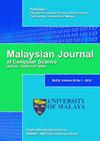LICENSE PLATE RECOGNITION TECHNIQUES: COMPARATIVE STUDY
IF 1.2
4区 计算机科学
Q4 COMPUTER SCIENCE, ARTIFICIAL INTELLIGENCE
引用次数: 0
Abstract
Vehicle License Plate Recognition (LPR) has become a crucial system for various applications such as security monitoring, parking access, law enforcement and so on. LPR is employed for the identification of vehicles using their license plate. Recently, LPR technology has evolved progressively where vast improvement had been made towards the development of the image recognition’s quality and speed, as well as its state of the art methods. Although several research studies managed to resolve most of the issues that arise in LPR systems, more studies need to be conducted to improve the performance of LPR. This paper aims to provide a comprehensive analysis and comparison of different methods used in LPR. It summarizes each of the methods in terms of their accuracy, performance, strengths and weaknesses. Based on the recognition techniques used, LPR is then characterized into two categories, namely Traditional Computer Vision and Deep Learning Techniques.车牌识别技术的比较研究
车牌识别(LPR)已成为安全监控、停车通道、执法等各种应用的关键系统。LPR用于识别使用车牌的车辆。近年来,LPR技术不断发展,在图像识别的质量和速度以及最先进的方法方面取得了巨大的进步。尽管几项研究成功地解决了LPR系统中出现的大多数问题,但还需要进行更多的研究来提高LPR的性能。本文旨在对LPR中使用的不同方法进行全面的分析和比较。它总结了每种方法的准确性、性能、优点和缺点。基于所使用的识别技术,LPR被分为两类,即传统计算机视觉和深度学习技术。
本文章由计算机程序翻译,如有差异,请以英文原文为准。
求助全文
约1分钟内获得全文
求助全文
来源期刊

Malaysian Journal of Computer Science
COMPUTER SCIENCE, ARTIFICIAL INTELLIGENCE-COMPUTER SCIENCE, THEORY & METHODS
CiteScore
2.20
自引率
33.30%
发文量
35
审稿时长
7.5 months
期刊介绍:
The Malaysian Journal of Computer Science (ISSN 0127-9084) is published four times a year in January, April, July and October by the Faculty of Computer Science and Information Technology, University of Malaya, since 1985. Over the years, the journal has gained popularity and the number of paper submissions has increased steadily. The rigorous reviews from the referees have helped in ensuring that the high standard of the journal is maintained. The objectives are to promote exchange of information and knowledge in research work, new inventions/developments of Computer Science and on the use of Information Technology towards the structuring of an information-rich society and to assist the academic staff from local and foreign universities, business and industrial sectors, government departments and academic institutions on publishing research results and studies in Computer Science and Information Technology through a scholarly publication. The journal is being indexed and abstracted by Clarivate Analytics'' Web of Science and Elsevier''s Scopus
 求助内容:
求助内容: 应助结果提醒方式:
应助结果提醒方式:


